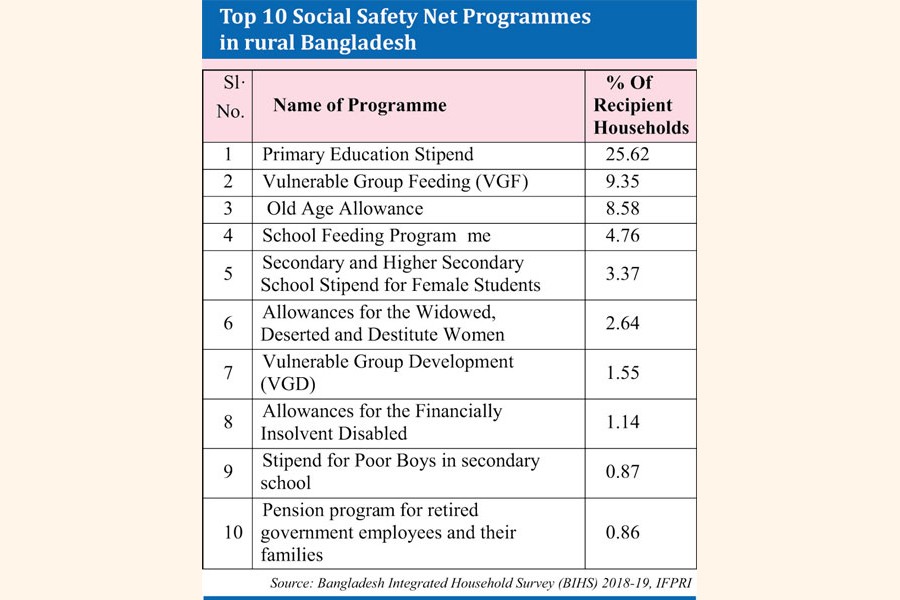
 Bangladesh has a significant experience in helping the poor through social safety nets and protection programmes. Social protection in Bangladesh has been evolving since the 1970s through innovation and experimentation. The country allocates a significant share of its national budget to run the programmes. In the fiscal year 2018-19, the government allocated BDT 642 billion (USD 8 billion) for social protection that is inclusive of government pensions or about 2.5 per cent of GDP and 13.8 per cent of the total budget. The social protection system included 145 programmes covering 80.8 million beneficiaries in the fiscal year 2014-15 (GED 2015).
Bangladesh has a significant experience in helping the poor through social safety nets and protection programmes. Social protection in Bangladesh has been evolving since the 1970s through innovation and experimentation. The country allocates a significant share of its national budget to run the programmes. In the fiscal year 2018-19, the government allocated BDT 642 billion (USD 8 billion) for social protection that is inclusive of government pensions or about 2.5 per cent of GDP and 13.8 per cent of the total budget. The social protection system included 145 programmes covering 80.8 million beneficiaries in the fiscal year 2014-15 (GED 2015).
Building rights-based social safety net programmes have become an issue of importance for policymakers across the globe after the onset of the Coronavirus (COVID-19) pandemic. Both developing and developed countries are now facing the challenging task of mitigating the adverse impacts of the pandemic, which has been aggravated by the ongoing conflict between Russia and Ukraine. These crises have made the global economy much more vulnerable, and the poorest of the poor face stringent consequences, which can be directly attributed to the rising food and fuel prices and high unemployment in the informal sector, especially in countries like Bangladesh.
A recent survey conducted on 1200 households by the World Food Programme (WFP) found that around 68 per cent of people in the country struggled to buy food. According to the report, 22 per cent of the surveyed households were moderately food insecure in August, which was 29 per cent in July. Moreover, 42 per cent of the low-income households were moderately food-insecure, and their situation had worsened. The reason behind this predicament was reported to be severe price hikes, increases in fuel prices, natural hazards and an increase in diseases and health-related problems.
These findings reaffirm that policymakers must focus on strengthening the existing social protection system and expanding its base so that the programmes cover the struggling portion of society. Experts have opined that some challenges and issues remain in the existing system. The targeting errors of exclusion (needy people are omitted from the programme) and inclusion (non-needy people are included in the programme) are large in most programmes. Many programmes have limited coverage, are uncoordinated, and are not adequately funded. Programme resources and benefits to programme participants are too thin. The size of transfers to safety net participants is too small in most programmes.
For example, results of the International Food Policy Research Institute (IFPRI)'s 2018-19 Bangladesh Integrated Household Survey (BIHS), which is a nationally representative rural survey at the divisional level, show that the primary education stipend programme (PESP) has the largest coverage nationally (26 per cent of rural households). However, the size of the transferred entitlement is extremely small: 100 taka per month for 1 student and 200 taka per month for 2 students from one household.
On average, programme participant households in the BIHS sample received 103.41 taka-month, which accounts for less than one per cent (only 0.6 per cent) of the total average monthly consumption expenditures of transfer recipient households. The transfer amount is not big enough to create a significant difference in the lives and livelihoods of the poor and vulnerable.
There is a lack of safety nets available to the urban poor. In 2010, 30.1 per cent of rural households benefited from a social safety net programme compared with only 9.4 per cent of urban households (GED 2015). The rapid urbanisation of Bangladesh calls for a range of measures to tackle urban food insecurity; a strong safety net or social protection system for the urban poor is an important one. After the onslaught of the COVID-19 pandemic, it was realised that poverty is perhaps now an urban phenomenon. Poorer urban households have suffered more due to the loss of income and jobs compared to their rural counterparts, who showed more resilience during the tumultuous times of COVID-19, and threats posed by the current high inflation rate.
Indeed, policymakers must focus on supporting the poor and vulnerable through the social protection system by increasing coverage of effective programmes. Effective programmes must be scaled up, and the programme budget must be adjusted accordingly. Programmes can be designed so the beneficiaries can self-select and enrol themselves in the programmes. The Employment Generation Programme for the Poorest (EGPP) and the Vulnerable Group Feeding (VGF) programme targeted the poorest most effectively, perhaps due to this attribute by design.
The existing protection system should be revamped, and the programme coverage should be expanded while making the transfer amount significant for the beneficiaries. Targeting errors must be minimised; a social audit system can be implemented at the community level for this purpose. Programmes with similar types of objectives and targeting criteria should be consolidated and simplified so that the administrative cost of running a plethora of programmes is minimised as well. High-cost, inefficient programmes must be phased out.
The overall monitoring and evaluation system must be improved, and the programmes must be revisited periodically to assess their efficacy. The size of transfers must be increased to generate substantial impacts on food security and nutritional outcomes. Nutrition-sensitive safety net programmes must be promoted by integrating nutrition behaviour change communication (BCC) to ensure food and nutrition security. Urban slums are potentially promising areas for expanding the system, although the high mobility rate of poor urban households may create some issues regarding the sustainability of the programmes. A sustained and renewed focus towards programmes designed specifically for the urban poor is needed.
COVID-19 exposed us to an unprecedented emergency, so now we must work with a sense of urgency. National social security strategy (NSSS) emphasises transitioning the system from food to cash. Since the world economy is facing unprecedented inflationary pressure, food prices must be kept low; otherwise, the social safety net programmes' cash assistance would not make any difference. The transfer amounts cannot be changed very frequently to adjust for inflation. Bangladesh spent about BDT 1,500 billion (US$ 18.7 billion) on social protection from FY2013-14 to FY2017-18, but at the same time, one-fifth of our total population is poor, which is a bit puzzling.
The core issue is more than the overall resources devoted to social protection. It seems to be around how well these resources are deployed. We must act now to address the inconsistencies and reimagine the protection system to address the new challenges and move beyond coping approaches to risk-reduction approaches. A framework consisting of four pillars of social protection should be envisaged - social assistance, social insurance, labour market policies and social care and shared burden between the public and the private sector.
Md Sadat Anowar is a Research Analyst at the International Food Policy Research Institute (IFPRI).
sadatanowarsunny@gmail.com
© 2025 - All Rights with The Financial Express
